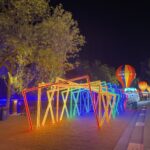The Nanjing Museum is located at the southern foot of Purple Mountain, to the north inside Zhongshan Gate. Here, you can see ancient relics such as the golden thread robe from the novel ‘The Lost Tomb’, appreciate the art of calligraphy and painting, and even take a walk on the old streets for a journey through time.
The historical museum was planned in 1933 and completed in 1948, with the main hall designed to resemble the mountain gate of Dulun Temple in Tianjin. After an expansion in 2009, it was opened to the public on November 6, 2013, becoming the second-largest museum in China after the National Museum of China. It houses six pavilions: the History Pavilion, Special Exhibition Pavilion, Digital Pavilion, Art Pavilion, Republic of China Pavilion, and Intangible Cultural Heritage Pavilion. The layout of the museum is divided into two main sections. After walking a short distance to the right, you will find the old main hall of the museum, which imitates Dulun Temple and is now used for security checks. Behind ‘Dulun Temple’ is the History Pavilion, and the other five pavilions are located to the left. You can tour from the five pavilions on the left to the History Pavilion on the right, or vice versa. It is recommended to start with the History Pavilion, as the Special Exhibition Pavilion, which houses the ‘Treasure of the Museum’, is located to the left of the History Pavilion. You can visit the entire museum in the following order: History Pavilion – Special Exhibition Pavilion – Digital Pavilion – Republic of China Pavilion – Art Pavilion – Intangible Cultural Heritage Pavilion. In the History Pavilion, you can see artifacts arranged in chronological order from prehistoric times to the Ming and Qing dynasties, as if walking through the 5,000-year civilization of Jiangsu. Notable exhibits include: dinosaur skeletons from prehistoric times; golden and silver thread robes; and walls made of bricks from the Northern and Southern Dynasties, with faint brick carvings of the ‘Seven Sages of the Bamboo Grove’. The Special Exhibition Pavilion features the ‘Prosperous Era’ section with Qing Dynasty official kilns, ‘Clock and Watch Exhibition’ with ancient Chinese timekeeping devices and Western clocks, and ‘Approaching Buddha’ with exquisite golden Buddha statues. The ‘Treasure of the Museum’, a gilded Tibetan-style pagoda from the early Ming Dynasty (1436-1439 AD), occupies an entire room with its grandeur. This treasure was unearthed from the underground palace of Hongjue Temple Pagoda at Niushou Mountain in Nanjing. On a square red sandstone base, four blue and white porcelain vases surround the golden pagoda, with a small golden coffin and silver coffin in front of the pagoda, and a golden reclining Buddha statue lying on the coffin. The Digital Pavilion uses modern technology to present ancient themes, such as the animation ‘Nanjing Prosperous Scenery Scroll’ (similar to the ‘Along the River During the Qingming Festival’ in the China Pavilion at the World Expo). What’s interesting is that there are many interactive games here, where you can touch the screen to play ancient-themed games. The Art Pavilion displays sculptures, calligraphy, and paintings. The paintings by Fu Baoshi on display are quite unique, as they use Chinese ink painting to depict Eastern European red-roofed buildings, squares, and sculptures.The Republic of China Hall in the Nanjing Museum is designed to resemble a street from the Republic of China era. There is a tram on the street. On both sides of the street, shops in the style of the Republic of China stand in rows and are open for business. Of course, what they sell are things that can evoke people’s memories. In a grocery store selling goods from north and south, you can buy ‘mouse droppings’ (also known as kumquat pills) that you ate when you were young. The post office can stamp with the postmark of the Nanjing Museum. In the Librairie Avant-Garde on the upper floor of the post office, the waiters are all dressed in clothes of that time. If you want to send postcards, you can also buy stamps at the bookstore. The Intangible Cultural Heritage Hall exhibits folk handicrafts such as woodblock printing, paper-cutting, gold foil, and lanterns. You can enjoy performances such as Kunqu Opera, Baiju Opera, and Pingtan here. Reference performance time: 14:00 – 16:00. In the small theater, you can watch a 3D film for free. The film is about 20 minutes long. The small theater in the Intangible Cultural Heritage Hall will be open to the public if there are traditional quyi performances at 19:00 on weekends and holidays. Tickets are required. Opening hours: Closed all day on Mondays throughout the year; From July 9 to August 31, open from 09:00 to 18:00 from Tuesday to Sunday; From September 1 to July 8, open from 09:00 to 17:00 from Tuesday to Sunday; Open from 09:00 to 21:00 on National Day. Service facilities: Scenic area interpretation: Cost: Voice-guided tour costs 20 yuan, and intelligent-guided tour costs 30 yuan; Interpretation time: 10:00 am and 2:00 pm; Gathering place: Information desk of the History Hall, Information desk of the Special Exhibition Hall, Information desk of the Art Hall. Audio guide rental: Reference price: free; Address: Information desk. There will be a free regular interpretation at 10:00 am and 2:00 pm every day in the History Hall and the Special Exhibition Hall. There will be a broadcast notice before the interpretation. Each session is for 30 people.









